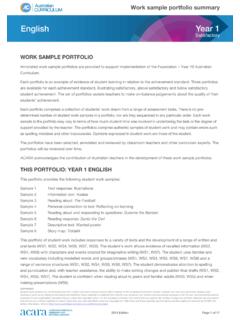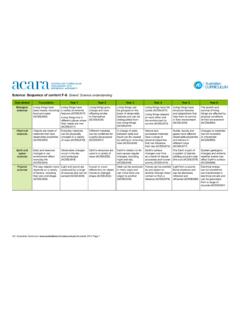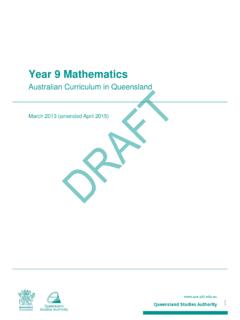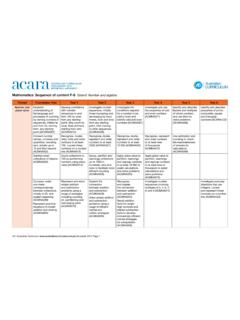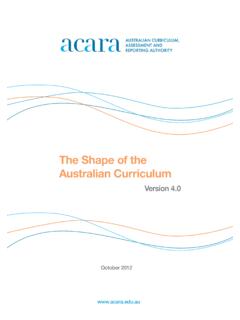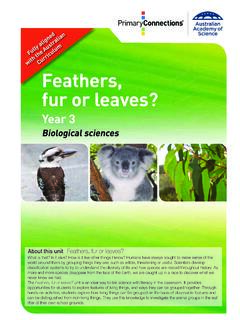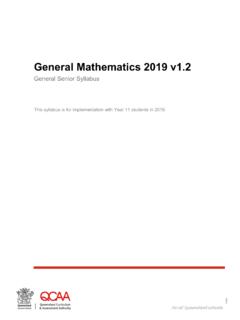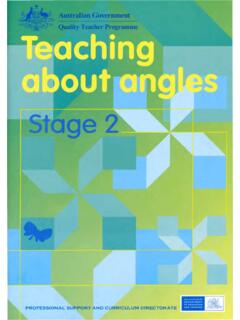Transcription of English as an Additional Language or Dialect Teacher Resource
1 English as an Additional Language or Dialect Teacher Resource EAL/D Learning Progression: Foundation to Year 10. June 2015. All material in this brochure is subject to copyright under the Copyright Act 1968 (Cth) and is owned by the australian curriculum , Assessment and Reporting Authority (ACARA) 2013. Licence Unless otherwise noted, all material in this brochure except the logo of ACARA, third party icons and any material protected by trademark is licensed under a Creative Commons Attribution-NonCommercial-ShareAlike Australia (CC BY NC SA) licence identified by the following logo: Under a CC BY NC SA Licence, you may download, copy, print and communicate material for personal or non-commercial purposes, including educational or organisational use, provided you attribute ACARA and licence any new work created incorporating material from this website under the same CC BY NC SA Licence. Attribution (Credit ACARA).
2 All ACARA material licensed under the CC BY NC SA licence must be attributed in the following manner: Unmodified ACARA material: You must credit ACARA in the following manner: Source: australian curriculum , Assessment and Reporting Authority (ACARA). Modified ACARA material: You must credit ACARA in the following manner: Based on australian curriculum , Assessment and Reporting Authority (ACARA) materials Copyright inquiries For all copyright inquiries, please email: or phone: 1300. 895 563 (if within Australia) or 61 2 8098 3100 (if outside Australia). TABLE OF CONTENTS. ABOUT THE Resource .. 4. EAL/D LEARNING PROGRESSION .. 5. VIEW BY STAGE OF SCHOOLING .. 8. Beginning English : Some print literacy in first Language .. 9. Foundation to Year 2 .. 10. Years 3 to 6 .. 12. Years 7 to 10 .. 14. Beginning English : Limited Literacy 16. Foundation to Year 2 .. 17. Years 3 to 6 .. 18. Years 7 to 10 .. 19. Emerging English .
3 20. Foundation to Year 2 .. 21. Years 3 to 6 .. 24. Years 7 to 10 .. 27. Developing English .. 29. Foundation to Year 2 .. 30. Years 3 to 6 .. 33. Years 7 to 10 .. 36. Consolidating English .. 39. Foundation to Year 2 .. 40. Years 3 to 6 .. 42. Years 7 to 10 .. 45. VIEW BY Language MODES .. 48. Listening .. 49. Beginning English .. 49. Emerging 51. Developing English .. 53. Consolidating English .. 56. Speaking .. 58. Beginning English .. 58. Emerging 60. Developing English .. 62. Consolidating English .. 65. Reading/Viewing .. 67. Beginning English : some print literacy in first Language .. 67. Beginning English : Limited Literacy Background .. 69. Emerging 71. Developing English .. 73. Consolidating English .. 76. Writing .. 78. Beginning English : Some Print Literacy in First Language .. 78. Beginning English : Limited Literacy Background .. 80. Emerging 82. Developing English .. 85. Consolidating English .
4 88. 3. ABOUT THE Resource . The Shape of the australian curriculum describes ACARA's commitment to supporting equity of access to the australian curriculum for all students. As part of this commitment, ACARA developed the English as an Additional Language or Dialect Teacher Resource to support teachers as they develop teaching and learning programs in the australian curriculum : Foundation to Year 10 with students for whom English is an Additional Language or Dialect (EAL/D). The English as an Additional Language or Dialect Teacher Resource is available as several related publications: EAL/D Overview and Advice EAL/D Learning Progression Foundation to Year 10. EAL/D Annotated Content Descriptions Foundation to Year 10 for each of English , mathematics , Science and History Student Illustrations of EAL/D Learning Progression Foundation to Year 10. Additional components of the Resource will be published as the australian curriculum is developed.
5 All publications are available on the australian curriculum Website. The Resource has been developed to: advise teachers about areas of the curriculum that EAL/D students may find challenging and why assist classroom teachers to identify where their EAL/D students are broadly positioned on a progression of English Language learning help teachers understand students' cultural and linguistic diversity, and the ways this understanding can be used in the classroom provide examples of teaching strategies supportive of EAL/D students direct teachers to Additional relevant and useful support for teaching EAL/D. students. Throughout the Resource , English refers to Standard australian English . English as an Additional Language or Dialect Teacher Resource : EAL/D Learning Progression Foundation to Year 10. 4. EAL/D LEARNING PROGRESSION. This publication comprises an EAL/D learning progression typical of EAL/D students that will help teachers to identify the English Language levels of the EAL/D students in their classrooms and address the EAL/D student's specific learning requirements.
6 This learning progression is available in two views by stage of schooling (Foundation to Year 2; Years 3 6 and Years 7-10) and by Language mode . Speaking; Listening; Reading and viewing and Writing. Introduction This EAL/D learning progression describes a progression of English Language learning typical of students learning English as an Additional Language or Dialect (EAL/D). It has been developed primarily for teachers who are not EAL/D specialists. EAL/D or English as a Second Language (ESL) documents developed by the states and territories provide for more detailed and specialist information. Teachers can use this progression to: understand the broad phases of English Language learning that EAL/D. students are likely to experience identify where their EAL/D students are located on the progression and the nature of their speaking, listening, reading/viewing and writing skills monitor the linguistic progression of their EAL/D students.
7 By considering examples of EAL/D students' work, including their speaking and listening skills, teachers can identify linguistic elements and/or behaviours that best match those found in the EAL/D learning progression. This will indicate the level of support that will need to be provided for students to access learning area content. The publication, Student Illustrations of the Learning Progression Foundation to Year 10 contains annotated examples of student work that illustrate characteristics of students at each stage of schooling for most phases on the EAL/D learning progression. The collection will be added to over time. Examples of considerations and strategies to assist teachers to adapt their curriculum delivery can be found in the advice for teachers of EAL/D students. Student progress can be monitored at key points in the school program (such as reporting times) by referring to the EAL/D learning progression.
8 The EAL/D learning progression includes: broad descriptions of the characteristics of learner groups at each of four phases of English Language learning. EAL/D students of any age may be in any of the Language learning phases: o Beginning English students with some print literacy in their first Language . A subcategory, Limited Literacy Background, is included to English as an Additional Language or Dialect Teacher Resource : EAL/D Learning Progression Foundation to Year 10. 5. describe the reading/viewing and writing behaviours typical of students with little or no experience of literacy in any Language o Emerging English students who have a growing degree of print literacy and oral Language competency with English o Developing English students who are further developing their knowledge of print literacy and oral Language competency with English o Consolidating English students who have a sound knowledge of spoken and written English , including a growing competency with academic Language .
9 Tables that describe an English Language learning pathway typical of EAL/D. students for: o three stages of schooling (Foundation to Year 2, Years 3 to 6, Years 7 to 10). o the four phases of Language proficiency in each stage of schooling o the Language modes of listening, speaking, reading/viewing and writing in each of the four phases. The EAL/D learning progression is presented in two views. One view is organised by stage of schooling and phase of Language learning. The second view is organised by the Language modes of speaking, listening, reading/viewing and writing. Both views contain the same information. Important considerations when using the EAL/D learning progression The EAL/D learning progression provides teachers with a brief summary of an English Language learning progression that EAL/D students typically make. It can take many years for an EAL/D student to complete this progression. Each of the four phases describes a period of significant English Language learning development, and there will be differences between a student at the beginning of the phase and a student at the end of the phase.
10 EAL/D students will move through the four phases at different rates: some students may move through more than one phase in a school year; while some may take more than one year to move from one phase to another. Students may also be at different phases across the Language modes of listening, speaking, reading/viewing and writing. For example, a student may be showing characteristics of Developing English in speaking, while still at Emerging English in writing. Students may appear to slip' between phases at transition points, particularly between Developing English and Consolidating English or when they move from an Intensive English program to a mainstream class, as they meet new academic challenges that require increasingly sophisticated use of academic Language . For example, a student may appear to be in the Consolidating English phase in Year 6, but new Language demands encountered in high school may mean that a student is better described in the Developing English phase in Year 7.





